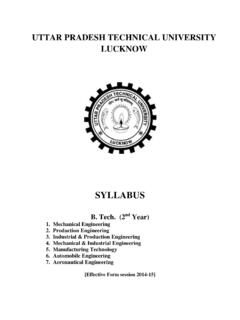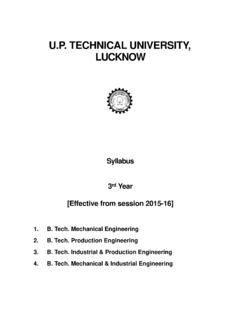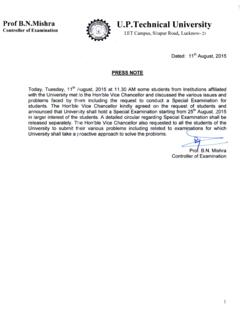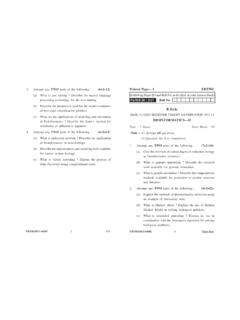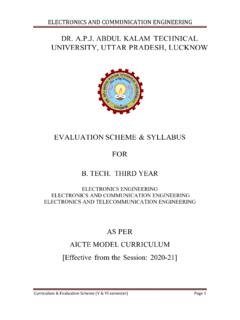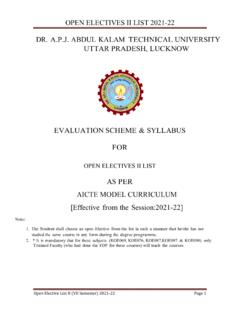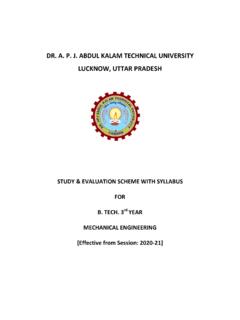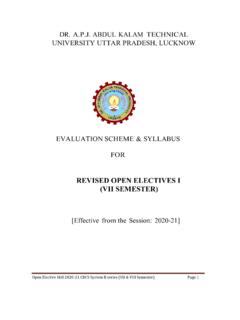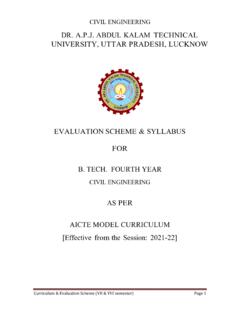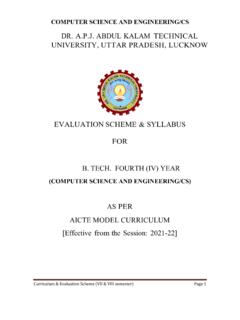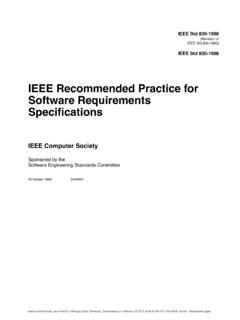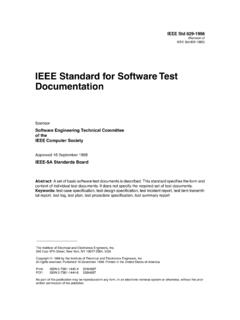Transcription of Computer Science & Business Systems
1 In Computer Science & Business Systems Semester 1 TCS Computer Science & Business Systems Semester 1 Curriculum in Computer Science & Business Systems Semester 1 Discrete Mathematics (PCC-CS401) Boolean algebra: Introduction of Boolean algebra, truth table, basic logic gate, basic postulates of Boolean algebra, principle of duality, canonical form, Karnaugh map. Abstract algebra: Set, relation, group, ring, field. Combinatorics: Basic counting, balls and bins problems, generating functions, recurrence relations. Proof techniques, principle of mathematical induction, pigeonhole principle. Graph Theory: Graphs and digraphs, complement, isomorphism, connectedness and reachability, adjacency matrix, Eulerian paths and circuits in graphs and digraphs, Hamiltonian paths and circuits in graphs and tournaments, trees; Planar graphs, Euler s formula, dual of a planer graph, independence number and clique number, chromatic number, statement of Four-color theorem.
2 Logic: Propositional calculus - propositions and connectives, syntax; Semantics - truth assignments and truth tables, validity and satisfiability, tautology; Adequate set of connectives; Equivalence and normal forms; Compactness and resolution; Formal reducibility - natural deduction system and axiom system; Soundness and completeness. Text Books: 1. Topics in Algebra, I. N. Herstein, John Wiley and Sons. 2. Digital Logic & Computer Design, M. Morris Mano, Pearson. 3. Elements of Discrete Mathematics, (Second Edition) C. L. LiuMcGraw Hill, New Delhi. 4. Graph Theory with Applications, J. A. Bondy and U. S. R. Murty, Macmillan Press, London. 5. Mathematical Logic for Computer Science , L. Zhongwan, World Scientific, Singapore. Reference Books: 1.
3 Introduction to linear algebra. Gilbert Strang. 2. Introductory Combinatorics, R. A. Brualdi, North-Holland, New York. 3. Graph Theory with Applications to Engineering and Computer Science , N. Deo, Prentice Hall, Englewood Cliffs. 4. Introduction to Mathematical Logic, (Second Edition), E. Mendelsohn, Van-Nostrand, London. in Computer Science & Business Systems Semester 1 STATISTICS, PROBABILITY AND CALCULUS Introduction to Statistics: Definition of Statistics. Basic objectives. Applications in various branches of Science with examples. Collection of Data: Internal and external data, Primary and secondary Data. Population and sample, Representative sample. Descriptive Statistics: Classification and tabulation of univariate data, graphical representation, Frequency curves.
4 Descriptive measures - central tendency and dispersion. Bivariate data. Summarization, marginal and conditional frequency distribution. Probability: Concept of experiments, sample space, event. Definition of Combinatorial Probability. Conditional Probability, Bayes Theorem. Probability distributions: discrete & continuous distributions, Binomial, Poisson and Geometric distributions, Uniform, Exponential, Normal, Chi-square, t, F distributions. Expected values and moments: mathematical expectation and its properties, Moments (including variance) and their properties, interpretation, Moment generating function. Calculus: Basic concepts of Differential and integral calculus, application of double and triple integral. Text Books: 1.
5 Introduction of Probability Models, S. M. Ross, Academic Press, 2. Fundamentals of Statistics, vol. I & II, A. Goon, M. Gupta and B. Dasgupta, World Press. 3. Higher Engineering Mathematics, B. S. Grewal, Khanna Publication, Delhi. Reference Books: 1. A first course in Probability, S. M. Ross, Prentice Hall. 2. Probability and Statistics for Engineers, (Fourth Edition), I. R. miller , Freund and R. Johnson, PHI. 3. Introduction to the Theory of Statistics, A. M. Mood, Graybill and Boes, McGraw Hill Education. 4. Advanced Engineering Mathematics, (Seventh Edition), Peter V. O'Neil, Thomson Learning. 5. Advanced Engineering Mathematics, (Second Edition) M. D. Greenberg, Pearson Education. 6. Applied Mathematics, Vol. I & II, P. N. Wartikar and J.
6 N. Wartikar, Vidyarthi Prakashan. in Computer Science & Business Systems Semester 1 FUNDAMENTALS OF Computer Science + Lab General problem Solving concepts: Algorithm, and Flowchart for problem solving with Sequential Logic Structure, Decisions and Loops. Imperative languages: Introduction to imperative language; syntax and constructs of a specific language (ANSI C) Types Operator and Expressions with discussion of variable naming and Hungarian Notation: Variable Names, Data Type and Sizes (Little Endian Big Endian), Constants, Declarations, Arithmetic Operators, Relational Operators, Logical Operators, Type Conversion, Increment Decrement Operators, Bitwise Operators, Assignment Operators and Expressions, Precedence and Order of Evaluation, proper variable naming and Hungarian Notation.
7 Control Flow with discussion on structured and unstructured programming: Statements and Blocks, If-Else-If, Switch, Loops while, do, for, break and continue, goto labels, structured and un- structured programming. Functions and Program Structure with discussion on standard library: Basics of functions, parameter passing and returning type, C main return as integer, External, Auto, Local, Static, Register Variables, Scope Rules, Block structure, Initialisation, Recursion, Pre-processor, Standard Library Functions and return types. Pointers and Arrays: Pointers and address, Pointers and Function Arguments, Pointers and Arrays, Address Arithmetic, character Pointers and Functions, Pointer Arrays, Pointer to Pointer, Multi-dimensional array and Row/column major formats, Initialisation of Pointer Arrays, Command line arguments, Pointer to functions, complicated declarations and how they are evaluated.
8 Structures: Basic Structures, Structures and Functions, Array of structures, Pointer of structures, Self-referral structures, Table look up, typedef, unions, Bit-fields Input and Output: Standard I/O, Formatted Output printf, Formated Input scanf, Variable length argument list, file access including FILE structure, fopen, stdin, sdtout and stderr, Error Handling including exit, perror and , Line I/O, related miscellaneous functions. Unix system Interface: File Descriptor, Low level I/O read and write, open, create, close and unlink, Random access lseek, Discussions on Listing Directory, Storage allocator. Programming Method: Debugging, Macro, User Defined Header, User Defined Library Function, makefile utility. in Computer Science & Business Systems Semester 1 FUNDAMENTALS OF Computer Science + Lab (continued) Laboratory 1.
9 Algorithm and flowcharts of small problems like GCD 2. Structured code writing with: i. Small but tricky codes ii. Proper parameter passing iii. Command line Arguments iv. Variable parameter v. Pointer to functions vi. User defined header vii. Make file utility viii. Multi file program and user defined libraries ix. Interesting substring matching / searching programs x. Parsing related assignments Text Books: 1. The C Programming Language, (Second Edition) B. W. Kernighan and D. M. Ritchi, PHI. 2. Programming in C, (Second Edition) B. Gottfried, Schaum Outline Series. Reference Books: 1. C: The Complete Reference, (Fourth Edition), Herbert Schildt, McGraw Hill. 2. Let Us C, Yashavant Kanetkar, BPB Publications. in Computer Science & Business Systems Semester 1 PRINCIPLES OF ELECTRICAL ENGINEERING + Lab Introduction: Concept of Potential difference, voltage, current, Fundamental linear passive and active elements to their functional current-voltage relation, Terminology and symbols in order to describe electric networks, voltage source and current sources, ideal and practical sources, concept of dependent and independent sources, Kirchhoff-s laws and applications to network solutions using mesh and nodal analysis, Concept of work, power, energy, and conversion of energy.
10 DC Circuits: Current-voltage relations of the electric network by mathematical equations to analyze the network (Thevenin s theorem, Norton's Theorem, Maximum Power Transfer theorem) Simplifications of networks using series-parallel, Star/Delta transformation. Superposition theorem. AC Circuits: AC waveform definitions, form factor, peak factor, study of R-L, R-C,RLC series circuit, R-L-C parallel circuit, phasor representation in polar and rectangular form, concept of impedance, admittance, active, reactive, apparent and complex power, power factor, 3 phase Balanced AC Circuits ( - & - ). Electrostatics and Electro-Mechanics: Electrostatic field, electric field strength, concept of permittivity in dielectrics, capacitor composite, dielectric capacitors, capacitors in series and parallel, energy stored in capacitors, charging and discharging of capacitors, Electricity and Magnetism, magnetic field and Faraday's law, self and mutual inductance, Ampere's law, Magnetic circuit, Single phase transformer, principle of operation, EMF equation, voltage ratio, current ratio, KVA rating, efficiency and regulation, Electromechanical energy conversion.
